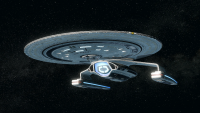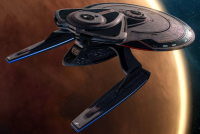Sutherland Class
The Sutherland-class research cruiser is a large science vessel derived from the Nebula-class heavy cruiser. It is intended to carry large-scale instruments into the field with large crews of scientific personnel; it is by far the largest dedicated science vessel in service. Compared to the Nebula, many of its exterior features have been simplified and it is more lightly armed. These vessels can mainly be found making use of their vast scientific and research capabilities to perform extremely detailed studies of planets, celestial phenomena, anomalies, and entire regions of space.
Class History
In 2384, the Advanced Starship Design Bureau received instructions from Starfleet Command to draw up plans for a new type of science vessel. Growing tensions in the Beta Quadrant caused concern within Starfleet over its ability to continue its exploration mandate should large portions of its fleet need to be repurposed for conflict with the rapidly destabilizing Romulan Star Empire. After two years of sifting through numerous design proposals, the Sutherland-class was the Bureau’s eventual response.
The design was favored above all because of its versatility. The chosen spaceframe borrowed heavily from the proven Nebula-class design concept. However, where the Nebula had been a generalist, involved in the full spectrum of combat operations, first contact missions, and diplomacy, the Sutherland would become a specialist. Indeed, the Sutherland was expected to be a “Swiss army knife” of Starfleet’s scientific operations. The ship is larger than its predecessor with even more internal modularity. This provides room for the kind of specialized science laboratories and research facilities that up until now has only been found on static Starfleet installations.
A wide range of large, customizable mission pods would be made available, further boosting the Sutherland’s ability to step into various logistical support roles throughout the fleet. Additions like the tactical pod provide captains with some limited combat capability should the need arise. As of 2400, however, the Sutherland’s main role remains as a scientific follow-up vessel for points of interest identified by initial surveys undertaken by Starfleet’s scouts and explorers. The ship has lived up to its design brief of being a one-stop-shop for identifying, analyzing, and disseminating research findings while remaining adaptable to the needs of the mission at hand.
Shipboard Life
Sutherland-class ships can be incredibly interesting and diverse places to serve aboard. Their considerable size makes for lively communities with plenty of activities available for those who wish to spend their downtime productively, or otherwise. Ships often possess arboretums, zoological centers, and stellar cartography domes along with the usual gamut of bars, lounges, and library archives.
The huge potential for cutting-edge research and specialist equipment attracts some of Starfleet’s keenest scientists. The science departments on these ships are so large that each ship becomes a self-sustaining research community. Even when no specific events take place, sub-department leads and area specialists will often give their own lectures and present their latest research findings to each other.
Engineers make up the second-largest department onboard the Sutherland. Keeping computer systems running optimally, fine-tuning finicky scientific apparatus, and transporting and building pre-replicated planetary structures are all potential situations an engineering officer may encounter. This environment favors officers who are jacks of all trades and who appreciate the fact that no two assignments will ever be the same.
Commanding such a large ship is no easy task. This assignment involves plenty of management skills when it comes to inter-departmental rivalries and egos that are liable to develop on a science vessel of this size. Captains must learn to balance the research needs of the scientific community with the practicalities of the engineers who make things happen. Friendly rivalries may develop into serious confrontations if not kept in check by a commanding officer with their ear firmly to the ground regarding shipboard goings-on. Pilots and command personnel might feel detached from these conflicts and must themselves be careful to avoid appearing aloof.
Vessels of Note
| Name | Registry | Status |
|---|---|---|
| USS Almagest | NCC-91870 | Active |
| USS Huygens | NCC-91814 | Active |
| USS Rustazh | NCC-86503 | Active |
| USS Ibn al-Haytham | NCC-91965 | Active |
| USS Sutherland | NCC-91800 | Active |

